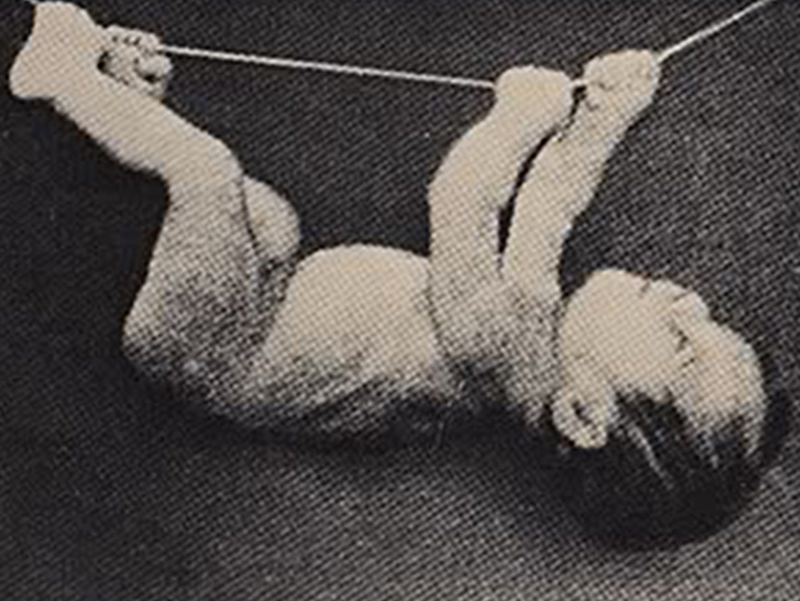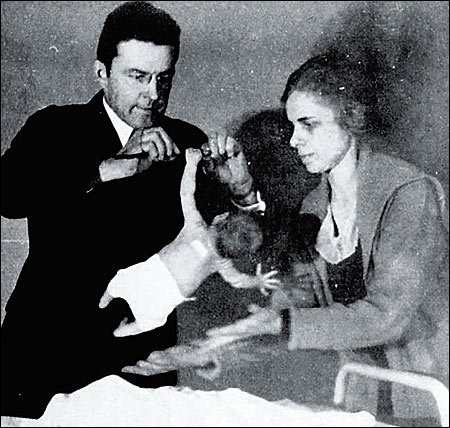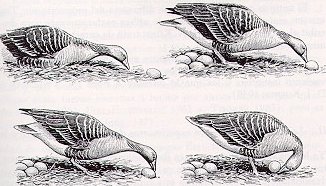The entirety of the animal kingdom operates on instincts. Our DNA has hardwired those behaviours in order to aid our survival. This is why they are often referred to as "survival instincts". They are simply behaviours that aim towards the preservation and propagation of an organism through various mechanisms of natural selection such as the one of group selection.
If we are to strip an instinct down to its basic constituents we would find a basic survival mechanism that has remained unaltered. This is what we call in biology a fixed-action-pattern. It is an innate behavior, almost like a reflex, that works much like a small computer program that once it starts going, almost always, fulfills a specific pattern to completion.
In humans we can check these fixed-action-pattern fairly easy from our newborns. First and foremost we have the Rooting Reflex which occurs when we stroke a baby's cheek with our fingers on breast. Almost always the baby will turn towards the finger/nipple to feed itself.
Support a baby's head and try to rock it forward towards an empty space and it will open it's hands, almost saying "catch me". This is the falsifiable demonstration Moro Reflex and it is well retained through adulthood. The behaviour simply acts in a way to protect the organism from harm while falling by stimulating an action that aims to grab from somewhere. Newborns that lack this basic instinct often have neurological problems such as down syndrome. Fixed action patterns such as this one are used from doctors to evaluate a baby's health.
The fixed stepping action pattern occurs when we hold the babies up and their legs start stepping into place. This is a signal for initiating bipedalism.
Stroke the bottom of your babies feet and hands and it will curl them up, almost like a monkey. When I used to live with Aboriginal Communities many women threw the babies in their back and the grabbed on to the hair with a firm lock. This reflex has been studied extensively and some studied even noted that the babies will grab from things like ropes and rather have an inclination for hair. This is also noted in earlier primates. We also have to note here that the strength the baby demonstrates in his grip is rather impressive. We call this vestigial grasp and it is perhaps the most prominent fixed-action-pattern.
Cover a baby's head with a shirt or blanket and it will move its head left and right or pushing with her hands to get it off. The righting reflex evolves later on to protect the individual from the most sensitive part of the body — the head. This is also directly connected to the withdrawal reflex. Move your head or another object close to it and it will turn its head away.
Try to feed a baby and touch the tip of his tongue and it will push the food out. The tongue thrust reflex protects the baby choking from foreign object insertion. This is why it is rather pointless to attempt to feed the baby solid foods before it becomes at least 4 months old. It will spout everything out. Again, evolution to the rescue.
In zoology one of the most popular examples of these reflexes is the behaviour of the Graylag Goose. If the bird notices an egg displaced from the nest it will roll the egg back into the nest. The key point here is that the goose will complete the action even if the eggs is removed while the bird is trying to complete the action. This what makes the act of the Goose resemble a reflex.
The reason that fixed-action-patterns tend to diminish as we become older is because they are slowly camouflaged through culture. Nurture trumps nature at the end of day but only after it has build upon it. This is why we see some women getting excited when two men fight for them. Primates always antagonize each other for competition in copulation and females will mate with the one that is most fit. In the same way a muscular body appears more desirable because it illustrates health.
Another example would be a discussion over a meal will more likely bring a deal to its completion as much as a warm cup of tea will make someone more agreeable. All these behaviours are elaborate manifestations of simple survival instincts ( or fixed-action-patterns) that become more elaborate as our culture becomes more complicated. A monkey will try to control resources and it will dominate the tribe as much as a rich man with a large estate and a fat bank account will.
There are more subtle fixed actions patterns that can be studied and even falsified in order to make the theory more robust. Invite someone over and will almost always offer them something to drink. Enter an elevator and you will always try to face the door. If you think that these behaviours are not compulsive then try not to do them and you will feel uncomfortable even anxious. In the same way we could stop a goose from rolling the egg but it's desire would not go away shortly after.
If you also think that this involves only primates affected by culture then think again. Crows are known to have developed their own fixed-action-patterns and they are as recent as the modern road system. They simply take nuts and place them in roads in order for the cars to crack them open. This behaviour has been carried out so much that has become a fixed action pattern that serves as a pivotal mechanism for their survival in some areas.
It is natural to try and distinguish ourselves from the rest of the animal kingdom by invoking terms such as "values" and "ethics". The raw truth is that through the evolutionary process some actions are hardwired so much that they define entirely who were are and where we are headed. We will look after our clan and family because of genetic patriotism much like any other species. We will even sacrifice our genes for the sake of a new, better copy with more information in it.

This is why acat will run away if you attack it when there are no newborn kittens for her to defend but will stand her ground even if it causes her own death if she has some. The cat does not abide to heroism. It abides to its own survival instincts, her own fixed action pattern that dictates her to stay there and defend her babies no matter what. In humans, it gets more complicated because of the complexity of culture. For example, if you are in heavy populated area in China you are less likely to be acknowledged if you have a problem in the middle of the street. If on the other hand you are on a less populated area people will be more likely to assist you. This is not so fixed by every individual but due to the fact that we always study populations and not individual members of species the correlation becomes strong enough to make a case for a more elaborate fixed-action-pattern.
Traditionally survival instincts challenged humans because their prevalence renders us to just another animal. Philosophers and religions tried to work around them by inventing terms such as "values" and "ethics" but at the end of the day, everything is reduced to its basic fixed pattern constituents. Fixed-Action-Patterns define all of our survival instincts and shape the way we act in our environment. The better we understand where they stem from the better chance we have understanding ourselves.
For the sake of discussion I would like to challenge anyone to come up with a human behaviour that is not directly bound to a fixed action pattern. Please make sure to support your argument with evidence.





